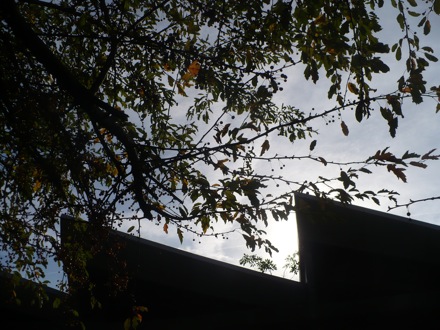
This is the university where I do my research, this year. I like this picture because it has nothing, nothing, nothing to do with the overdetermined and crass narratives that so easily predetermine one’s whole perception of this campus space. This is the tree that has grown up behind the amphitheatre with its jagged roof, the arms of the branch entirely geometrically incompatible with the sawtooth linearity of the dark building. There’s nothing here about politics, nothing here about pedagogy, this picture contains no academic knowledge, it embodies no concept unless you count the concept of mute visual juxtaposition of organic and inorganic form. There’s no knowledge in this picture, no sociality, no people, no conversation, no texts, no pedagogy, no politics, no record of human activity besides the roof built to some absent architect’s scheme. It’s autumn but you wouldn’t know that except from a couple of tiny leaves that gleam yellow in the underexposed daylight.

If we look to the left we can see that I was in an empty courtyard, where I had retreated one afternoon to write my fieldnotes and gnaw my sandwich undisturbed on a bench. It’s a site meant for human interaction: we see the sulky lips of the concrete benches curled over as if waiting for someone to sit down and converse merrily; but no one’s there, as the site is slightly out of the usual circulation patterns and the pedestrian bridge that normally brings traffic through this area is closed for some sort of repairs. Trees stoop low almost sagging. Leaves are scattered across the asphalt and some of them are falling into the storm drain. The shadow of the rooftops leaves behind inversely jagged sunshine. Funny how such a small shift in the camera’s angle can shift the colors so completely; the high contrast of sky and twigs has been replaced by drably sunny grey and brick and ragged green and hints of graffiti.

Another day later in the fall the sun came out of a cloud and the trees began to look more barren. This peculiar street, a service road really, just dead-ends in the fence which marks the end of campus. I cannot adequately stress how peculiar it is that this campus has only one public entrance and otherwise is completely encircled by a wall; I suppose there must be a gate at the end of this little road, but I have yet to see it opened. Down there where the curve of the road ends, you can’t see him in the contrast and the low resolution but a young guy was sitting by himself on the bench, hunched over something in his lap like a book, as if keeping intentionally as far as possible from anyone. It was one of those days where the afternoon sunlight wavered and threatened to withdraw altogether as if at the end of a sulky monologue.
Incidentally, I also feel certain that the planner who designed this road must have felt very clever to have contrasted the blocky grid of the brick building with the sinuous bends of the road and its bordering flowerbeds. And the wispy trees at right have a verticality that parallels that of the building at left, framing the road in the middle as if it ran through a valley with obstacles on both sides; although the organic trees are also and simultaneously the symbolic opposite of the building. Symbolically speaking, we can see on this campus and on many campuses an emergent opposition between the natural, which becomes ornamental as it is represented by carefully arranged decorative plant life, and the social, embodied by the brick and metal buildings where university life happens. Though what’s funny is that it’s often the buildings which evolve in unpredictable and convoluted ways, getting covered with graffiti or just plain worn out or repurposed or speckled with cigarette ash, while the ornamental campus trees often remain relatively untouched and unworn and continue to fulfill their assigned purpose as elements in a landscaped landscape. As if the built structures were actually more organic than the plant life, so carefully tended.
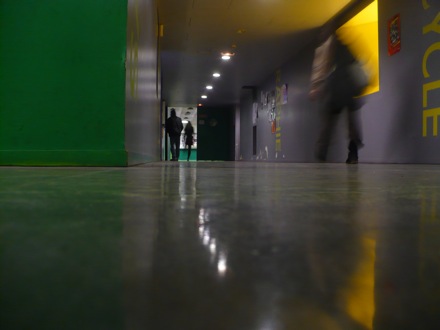
If we look inside the building, here in the corridor of the art department where philosophy classes also meet, the scene is more highly aestheticized, the floor shined, the light arranged, the walls colored in dramatic dark hues, the students coming and going like blurred creatures with bookbags, two people at the end of the hall approaching each other (is the one on the left waiting for the other, leaned on the wall?), everyone in dark clothes, posters marked the walls, paint chipped off near the floor (those white marks on the wall at right center) where passing feet have damaged things by accident. At times this hallway is packed with people waiting for their classes. Most of the rest of the time it just sits there waiting to be passed through.
Passing space. Quite often this corridor space of freedom and transition turns out to be more socially fruitful than the classrooms that it connects. This is a space where you see people make friends, where people make plans to meet later, where they inquire where the bathroom is (just on the right here before the doors), where they try to find the right classroom, where it’s easy to talk to strangers, where people sit on the floor trying to finish their lunch before class, where people sit waiting for someone to show up with the key, because classrooms are kept locked up when class isn’t in session, because of an ill-defined fear of misbehavior. This ill-defined fear is prevalent across campus, indicated by the barred windows on buildings within the campus, which is itself already walled in and guarded; and there is a definite class subtext to the security measures, an interpellation of the student body and of the neighborhood youth as a threat. Now, this corridor, and its twin on the next floor up (the cinema department), are visually nothing like the rest of campus; they’re remarkable for their boldly painted dark walls and their colored lighting effects; if you look at the end of this hallway you can see that normal fluorescent lights return out in the lobby. Still, the aesthetic differentiation of this corridor does nothing to lessen the pervasive security measures; I wouldn’t be surprised if over the last couple of months I’ve wasted an hour of my life, cumulatively, waiting for someone to show up with the key to the classroom. It’s a contradictory space, a space of visual differentiation and security concern and lively but very periodic sociability. Right before class is a good time to hang out. Other times, the hallway looks more lonely, and you feel loud and conspicuous if you’re talking, like the time on this very spot when I asked an old man about his PCF political background during the class break.
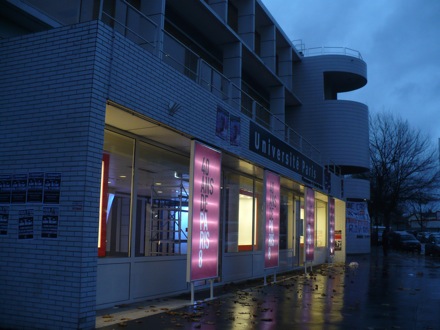
Outside the front gate of the university on a different day and more recently, on a cloudy day before (american) thanksgiving around nightfall, a series of pink banners announces the 40th anniversary of the university. An art exhibit is in the process of being mounted, scaffolding inside used to install things that hang from the ceiling or decorative lighting. Last year there were doors in this wall, and these doors were cracked and postered, and the interior of the room you see here was not an art exhibit but rather the university’s main and only entry hall, a gloomy but politically active space plastered with signs and slogans like “vive la lutte armée!” and battered vending machines and towers of chairs arranged as if leftover from barricades. (I wasn’t there for the barricades, but I heard someone say this fall that it was convenient, at the time, because if you needed a spare chair, you knew just where to find one.) Now the doors are gone and it’s glossy and someone has decided to spend money on backlit pink signs that glow in the blue of dusk. The university looms up in this photo, a tower of a chaotic building. And as we see from the signs, the university is also self-memorializing, a phenomenon often locally referred to as “nostalgia for ’68”; I fully expect that when the exhibit opens here, the chaotic political space that used to be there will be entirely replaced by fancy text and artfully chosen photos that aestheticize the messiness and incoherence and spontaneity of actual political action on campus. The genius of the culture industry that seizes on 1968 and other such glorious resistance fantasies lies in their ability to turn political spontaneity into a theme to be ritually commemorated and reinvoked.
As I took these pictures, no one was looking at this unfinished exhibit besides me. Someone came up behind me and said: “Salut, Eli!” I jumped. I wasn’t expecting to be seen. “Salut,” I say, “ça va?” but the kid had already walked away. Obligatory greetings at Paris8 can be interminable but also superficial.
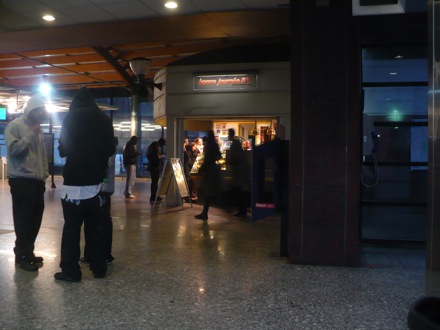
Across the street in the subway station there is a little bakery where people buy coffee and sandwiches. Or pastries. Sometime maybe I’ll write a structural analysis of campus eating establishments, but suffice it to say for the time being that this place, being a private establishment, charges €4.20 for a lunch special (un menu étudiant) versus €2.90 for the cheap sandwich deal at CROUS on campus. But the difference is that the sandwich at the bakery is far better tasting.
You can get an idea of the way that social life takes place here on the casual social ground of empty space in front of the subway gates. It was almost night and raining a little; people were clustered inside or under the eaves outside. The space had a regular rhythm, like any subway station; every four minutes a big crowd streamed out from the gates, having just gotten off the train, while in the other direction people trickled in towards the inbound platform at a lower and more even rate. This station is the end of the line. You can see in the picture three people (male) standing in baggy jeans and sweatshirts talking to each other, five or six people in line for pastries, a couple of people walking in towards the subway. It’s an anonymous space, part commercial, part social. It’s not a place where everyone is dressed in downtown Paris bourgeois getups.
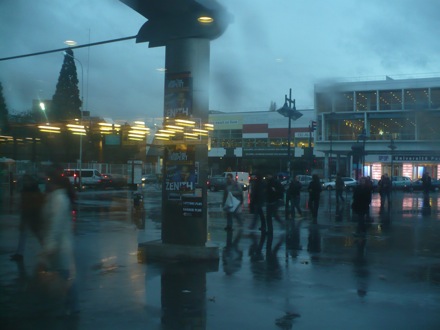
And if we look back towards campus out the window of the subway station we can see the little crowd of people, again mostly in dark clothes, many in jeans I think, but at any rate a large crowd who has finished class for the day and is going home, trickling towards the metro, crossing this large expanse of empty asphalt that is an even more transitional space than any campus hallway or courtyard. Sometimes people hang out here and smoke, but mostly people just rush back and forth, actually running, sometimes, when they’re late for class. (If you get off the train that arrives at 9:05 a.m., this is fairly common.) There’s a fruit stand out here too, just out of view at right, the type where if you only have 30 centimes or a ten euro bill for a 55 centime orange, the guy will probably just take the 30 centimes. You can see here that the courtyard is bleak, looks rained on, with a few dents and blemishes and tattered posters, and you can see that the aesthetic attention put into the interior campus landscaping doesn’t extend to this courtyard outside the campus gates, even though, by all rights, this courtyard is a far more central campus space than anything I showed above. You can’t go to this university without crossing this courtyard. At dusk the university glows in the dusk, the rows of lights show warm in the library windows against the cold gray of clouds and the cone of a single tree sticking up and a metro station pillar in the middle, and yes that’s the library glowing over there above the pink signs of the art exhibit I showed above. The reflections of the metro station’s lights swim through the photograph in a little school.
In this picture we see a university that isn’t visibly a “maoist university” (as someone described it) or necessarily “une université de banlieue” (a university of the outskirts) or “une Université-Monde” (a University-World) or “une aventure de la pensée critique” (an adventure of critical thought, as one current slogan would have it). Or to the extent that we do feel inclined to apply any of these retroactively produced labels to what we see, we can do so only through an exercise in classification that, at times, interferes with our comprehension of the social and visual spaces of the campus. They say that ethnography is an exercise in trying to understand the local understanding of local life, but sometimes local systems of classification can become an ethnographic burden, can interrupt and conceal the lived curiosities and contradictions of carelessly evolving ordinary worlds.

One thought on “Paris-8 by the light of different days”
Comments are closed.